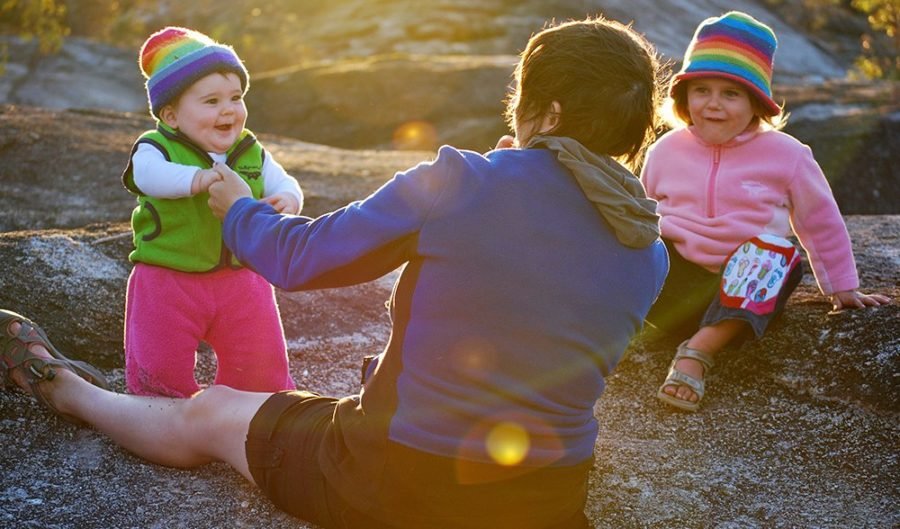How to camp with the kids

CHILDREN NATURALLY LOVE the outdoors – the simple things amaze them and the Australian bush has plenty to offer. The physical and mental gains of time outdoors for child development are well documented. We know the benefits of strength, endurance and building concentration, but time spent in the natural environment also exercises your children’s thinking, knowledge and mental wellbeing.
A camping trip is also a fantastic bonding opportunity for parent and children. Here are some tips from the Australian Geographic Adventure team (well, those with children, anyway) to help make camping a rewarding experience that kids will enjoy.
Where should you camp with the kids?
It’s a great idea to become familiar with local camping options so going bush can be enjoyed regularly and easily – you don’t need to drive for hours to a faraway location for children to enjoy the camping experience. The campsite could be at your local caravan/camping park, or an hour away at the most. Being close to home means you can make an easy retreat home if circumstances change, which is handy with really young kids.
The national parks website for your state is an excellent guide to many of the best spots around. Many national parks provide discovery programs (or similar) for children, usually operated by rangers during holiday periods.
What gear do you need for camping with the kids?
Modern camping gear has really taken the ‘feral’ out of family camping. The basics you’ll need for family comfort on a short camping trip are: a family tent, a tarp with poles and guide ropes, a couple of airbeds or foam bases, an esky or portable fridge/freezer, a gas cooker and lighting. Modern camping equipment is excellent, user-friendly and very accessible. For a relatively small initial investment you have a holiday option that’s available at short notice whenever you need.
Kids love to be empowered, and nothing is more empowering and motivating than heading out with your very own outdoor gear. An array of fantastic kids’ camping gear is available. Keep it simple; no flashy gadgets are needed – a colourful water bottle, backpack or a child-sized sleeping bag. But take it from me: the absolute winner is their own head torch.
Getting active with kids in tow
During your camping experience, take time to explore the natural surrounds. Pack a lunch and take a bushwalk, grab a canoe for a paddle or go beachcombing and build sand castles.
Preparation is key to a safe and enjoyable experience. Ensure you take a well-stocked first-aid kit and know the basics on how to use it. Take a map, even on marked trails; national parks websites and parks offices can provide these.
Pack all the regular outdoor essentials like sunscreen, hats, water and take enough food to cover the entire trip plus extra snacks or even an extra meal to cover unforeseen circumstances. Discomfort and hunger will quickly turn a great walk into a chore. Kids will burn more energy in the outdoors, so take more food than you would normally consider enough. Prepare familiar meals and snacks and have them easily accessible. Halfway down a bush track is not the place to try unfamiliar food. Keep your little ones hydrated, equip them with their own water bottle, and carry extra water yourself to top theirs up.
Camping with the kids should be fun
Keep in mind that a day in the outdoors will exhaust even the most active junior explorer. Expect bedtimes to be a little earlier than at home. It may be a good idea to bring dinner times forward and start your bedtime routine an hour or so earlier.
Fun, fun, fun. This should be your camping mantra. Learning will come, health benefits will come, as long as the experience is FUN.
Give your kids a disposable camera and let them take shots of whatever they feel like. It is great to get the images back and see what they have captured. Children usually take shots of smaller detail, often ignoring views while catching a bug or a flower or a rock instead.
Insect catching is another entertainer with an opportunity for the kids to learn. Make yourself aware of the local creepy crawlies to ensure no-one collects anything that may surprise. Build respect for all creatures by releasing them after a good look. Pick up a basic field guide. Kids love searching out and identifying birds or plants that they have spotted.
The most adaptable and versatile outdoor play option is your own creativity and imagination. Delving into their imaginary world and engaging with your children is truly rewarding for parent and child. Collect sticks and leaves to use later during a camp craft session. Remember to respect conservation-area guidelines for the removal of flora.
Create treasure hunts, search for fairy homes, and seek opportunities for storytelling and subtle lessons about animals and habitats. You are limited only by your imagination. Encourage the young ones to express themselves, to sing songs, tell jokes and laugh lots.
Don’t forget to let your kids explore and create their own play; so much of what they do these days is organised and structured. A nice grassy campsite or long empty beach can provide the perfect space for simply roaming about. Some of my favourite times are the spontaneous moments of unsupervised play, watching your little person engrossed in self-talk or just wandering about with a stick in hand without a care in the world – these are moments to treasure.
Remember to keep camping with the kids simple
For a very tentative child your first tent experience could be your very own backyard – that way if the sounds of the night get too much you can beat a hasty retreat indoors. You don’t need to climb a mountain to instill a love of the natural world and foster a lifetime of wonder.
RELATED STORIES:




